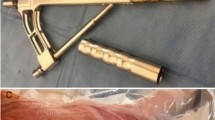Abstract
Background and purpose
Internal fixation is a therapeutic mainstay for treatment of undisplaced femoral neck fractures and fractures without posterior comminution. The best treatment for unstable and comminuted fractures, however, remains controversial, especially in older patients. The present study was designed to assess the utility of the Intertan Nail® (IT) for stabilization of comminuted Pauwels type III fractures compared to dynamic hips screw (DHS).
Methods
Randomized on the basis of bone mineral density, 32 human femurs were assigned to four groups. Pauwels type III fractures were osteomized with a custom-made saw guide. In 16 specimens the posteromedial support was removed and all femurs were instrumented with an IT or a DHS. All constructs were tested with nondestructive axial loading to 700N, cyclical compression to 1,400N (10,000 cycles), and loading to failure. Outcome measures included number of survived cycles, mechanical stiffness, head displacement and load to failure.
Results
Postoperative mechanical stiffness and stiffness after cyclical loading were significantly reduced in all constructs regardless of the presence of a comminution defect (p = 0.02). Specimens stabilized with the IT had a lower construct displacement (IT, 8.5 ± 0.5 mm vs. DHS, 14.5 ± 2.2 mm; p = 0.007) and sustained higher failure loads (IT, 4929 ± 419 N vs. DHS, 3505 ± 453 N; p = 0.036) than the DHS constructs.
Interpretation
In comminuted Pauwels type III fractures, the fixation with the IT provided sufficient postoperative mechanical strength, comparable rate of femoral head displacement, and a similar tolerance of physiological loads compared to fractures without comminution. The absence of the posteromedial support in comminuted fractures tended to reduce the failure load regardless of the fixation method.




Similar content being viewed by others
References
Johansson T, Jacobsson SA, Iverson I et al (2000) Internal fixation versus total hip arthroplasty in the treatment of displaced femoral neck fractures: a prospective randomized study of 100 hips. Acta Orthop Scand 71:597–602
Eisler J, Cornwall R, Strauss E et al (2002) Outcomes of elderly patients with nondisplaced femoral neck fractures. Clin Orthop 399:52–58
Lu-Yao GL, Keller RB, Littenberg B et al (1994) Outcomes after displaced fractures of the femoral neck. A meta-analysis of one hundred and six published reports. J Bone Joint Surg Am 76(1):15–25
Bonnaire FA, Buitrago-Tellez C, Schmal H et al (2002) Correlation of bone density and geometric parameter to mechanical strength of the femoral neck. Injury 33(Suppl 3):C47–C53
Sjostedt A, Zetterberg C, Hansson T et al (1994) Bone mineral content and fixation strength of femoral neck fractures. A cadaver study. Acta Orthop Scand 65(2):161–165
Audige L, Hanson B, Swiontkowski MF (2003) Implant-related complications in the treatment of unstable intertrochanteric fractures: meta-analysis of dynamic screw versus dynamic screw-intramedullary nail devices. Int Orthop 27(4):197–203
Baumgaertner MR, Solberg BD (1997) Awareness of tip-apex distance reduces failure of fixation of trochanteric fractures of the hip. J Bone Joint Surg Br 79(6):969–971
Bonnaire F, Zenker H, Lill Ch et al (2005) Treatment strategies for proximal femur fractures in osteoporotic patients. Osteoporos Int 16:93–102
Parker MJ (2002) Evidence-based results depending on the implant used for stabilizing femoral neck fractures. Injury 33(Suppl 3):C15–C18
Ruecker AH, Rupprecht M, Gruber M et al (2009) The treatment of intertrochanteric fractures: results using an intramedullary nail with integrated cephalocervical screws and linear compression. J Orthop Trauma 23(1):22–30
Sievänen H, Koskue V, Rauhio A et al (1998) Peripheral quantitative computed tomography in human long bones: evaluation of in vitro and in vivo precision. J Bone Miner Res 13(5):871–882
Bergmann G, Deuretzbacher G, Heller M et al (2001) Hip contact forces and gait patterns from routine activities. J Biomech 34(7):859–871
Windolf M, Braunstein V, Dutoit C et al (2009) Is a helical shaped implant a superior alternative to the dynamic hip screw for unstable femoral neck fractures? A biomechanical investigation. Clin Biomech 24:59–64
Denham RA (1959) Hip mechanics. J Bone Joint Surg Br 41:550–557
Kubiak EN, Bong M, Park SS et al (2004) Intramedullary fixation of unstable intertrochanteric hip fractures: one or two lag screws. J Orthop Trauma 18(1):12–17
Conn KS, Parker MJ (2004) Undisplaced intracapsular hip fracture: results of internal fixation in 375 patients. Clin Orthop 421:249–254
Heetveld MJ, Raaymakers ELFB, van Walsum ADP et al (2005) Observer assessment of femoral neck radiographs after reduction and dynamic hip screw fixation. Arch Orthop Trauma Surg 125:160–165
Selvan VT, Oakley MJ, Rangan A et al (2004) Optimum configuration of cannulated hip screws for the fixation of intracapsular hip fractures: a biomechanical study. Injury 35:136–141
Bhandari M, Devereaux PJ, Tornetta P 3rd et al (2005) Operative management of displaced femoral neck fractures in elderly patients. An international survey. J Bone Joint Surg Am 87(9):2122–2130
Meyers MH, Harvey JP Jr, Moore TM (1974) The muscle pedicle bone graft in the treatment in displaced fractures of the femoral neck: Indications, operative technique, and results. Orthop Clin North Am 779–792
Rau FD, Manoli A 2nd, Morawa LG (1982) Treatment of femoral neck fractures with the sliding compression screw. Clin Orthop Relat Res 163:137–140
Scheck M (1980) The significance of posterior comminution in femoral neck fractures. Clin Orthop Relat Res 138–142
Duda GN, Schneider E, Chao EYS (1997) Internal forces and moments in the femur during walking. J Biomech 30:933–941
Conflict of interest and funding
There is no conflict of interest and there was no funding.
Author information
Authors and Affiliations
Corresponding author
Rights and permissions
About this article
Cite this article
Rupprecht, M., Grossterlinden, L., Sellenschloh, K. et al. Internal fixation of femoral neck fractures with posterior comminution. International Orthopaedics (SICOT) 35, 1695–1701 (2011). https://doi.org/10.1007/s00264-010-1199-x
Received:
Accepted:
Published:
Issue Date:
DOI: https://doi.org/10.1007/s00264-010-1199-x




